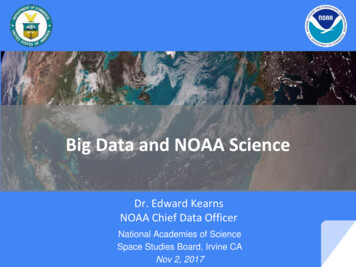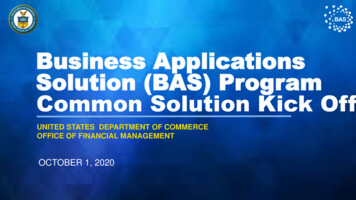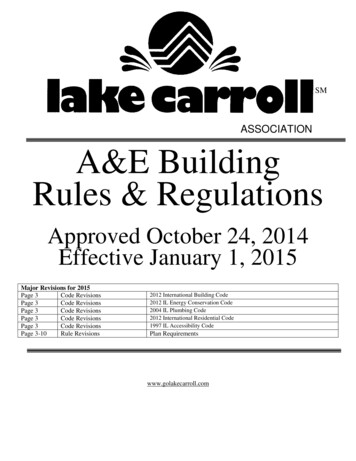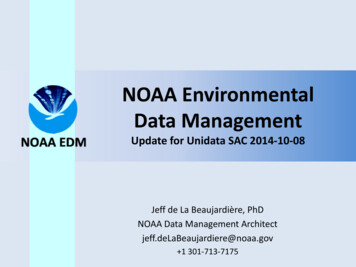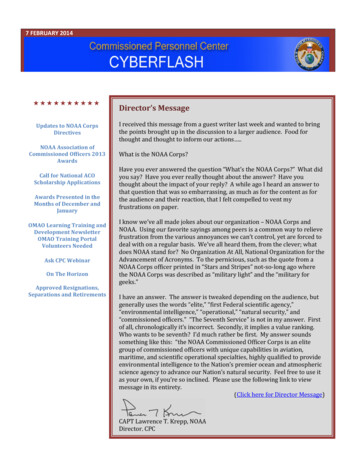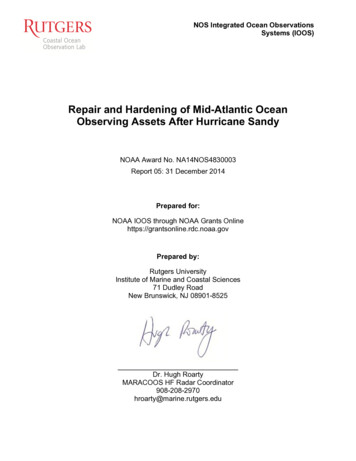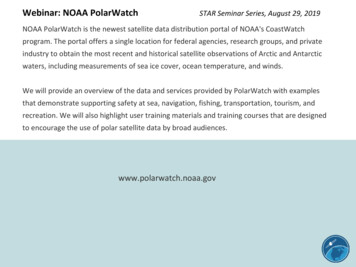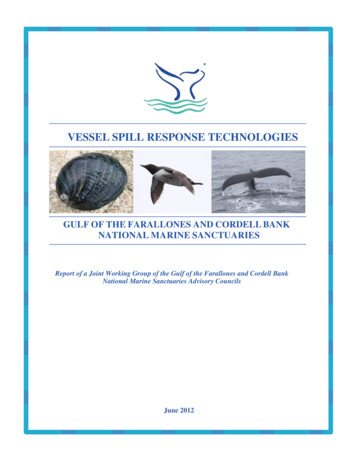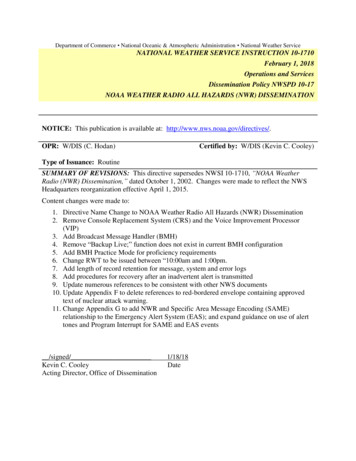
Transcription
Department of Commerce National Oceanic & Atmospheric Administration National Weather ServiceNATIONAL WEATHER SERVICE INSTRUCTION 10-1710February 1, 2018Operations and ServicesDissemination Policy NWSPD 10-17NOAA WEATHER RADIO ALL HAZARDS (NWR) DISSEMINATIONNOTICE: This publication is available at: http://www.nws.noaa.gov/directives/.OPR: W/DIS (C. Hodan)Certified by: W/DIS (Kevin C. Cooley)Type of Issuance: RoutineSUMMARY OF REVISIONS: This directive supersedes NWSI 10-1710, “NOAA WeatherRadio (NWR) Dissemination,” dated October 1, 2002. Changes were made to reflect the NWSHeadquarters reorganization effective April 1, 2015.Content changes were made to:1. Directive Name Change to NOAA Weather Radio All Hazards (NWR) Dissemination2. Remove Console Replacement System (CRS) and the Voice Improvement Processor(VIP)3. Add Broadcast Message Handler (BMH)4. Remove “Backup Live;” function does not exist in current BMH configuration5. Add BMH Practice Mode for proficiency requirements6. Change RWT to be issued between “10:00am and 1:00pm.7. Add length of record retention for message, system and error logs8. Add procedures for recovery after an inadvertent alert is transmitted9. Update numerous references to be consistent with other NWS documents10. Update Appendix F to delete references to red-bordered envelope containing approvedtext of nuclear attack warning.11. Change Appendix G to add NWR and Specific Area Message Encoding (SAME)relationship to the Emergency Alert System (EAS); and expand guidance on use of alerttones and Program Interrupt for SAME and EAS events/signed/Kevin C. CooleyActing Director, Office of Dissemination1/18/18Date
NWSI 10-1710 February 1, 2018NOAA Weather Radio All Hazards (NWR) DisseminationTable of Contents1234567PageIntroduction . 41.1Mission Connection . 41.2Fundamental Broadcast Concepts . 41.2.1 Use of NWR Automated Voice . 41.2.2 NWR “All Hazards” Concept . 51.2.3 Official Voice of the NWS . 5Technical Description . 5Procedural Responsibilities . 63.1Weather Service Headquarters (WSH) . 63.2Regional Headquarters . 63.3Weather Forecast Offices (WFO) . 63.3.1 Record Keeping . 63.3.2 NWR Outreach. 6Broadcast Programming Goal . 74.1Broadcast Service Area . 74.2Broadcast Quality. 74.2.1 Style of Presentation . 7Broadcast Message Priority . 85.1Broadcast Management Guidelines . 85.2Broadcast Content . 95.3Unauthorized Material . 95.4Non-Weather Related Announcements. 9Operations for Critical Events . 106.1Role of NWR in the National Warning System (NAWAS) . 116.2Initial Issuance of Short Duration Watches, Warnings and Related Statements . 116.3Programming after Initial Watch/Warning Issuances . 116.3.1 Watches for Tornadoes, Severe Thunderstorms and Flash Floods . 136.3.2 Warnings for Tornadoes, Severe Thunderstorms and Flash Floods . 136.3.3 Watches and Warnings for Winter Storms, High Winds, and Dust Storms . 136.3.4 Watches and Warnings for Hurricanes and Tropical Storms. 136.3.5 Warnings for Marine and Other Marine Events . 146.3.6 Watches, Warnings, and Related Statements for Floods . 146.3.7 Watches and Warnings for Tsunamis . 156.4Non-Weather Emergency Messages (NWEMs) . 156.4.1 Local Non-Weather-Related Emergencies Covered by Agreement. . 166.4.2 Local Non-Weather-Related Emergencies Not Covered by Agreement. . 166.4.3 National and Regional Non-Weather-Related Emergencies. 166.5Required Weekly Test (RWT) . 17Broadcast Outage and Suspension Rules . 177.1Notice of Planned or Unplanned NWR Facility Outage . 177.2Broadcast Suspension Rules . 187.2.1 Routine Request . 192
NWSI 10-1710 February 1, 20187.2.2 Emergency Request . 197.2.3Fire and Bomb Threats. 198Quality Assurance . 208.1Quality Assurance on Shift . 208.2Recovery after an Inadvertent Alert is Transmitted . 208.3Drills of Broadcast Rules for Critical Events . 218.4NWR Program Leaders . 219NWR as a Substitute for Other Means of Dissemination . 2110 Use of NWR by the Broadcast Industry . 2111 Restrictions under Operating License . 2212 Public Education and Promotion . 2212.1 General Promotion Activities . 2212.2 Promotion with the Broadcast Industry . 2313 Customer Feedback . 2414 Gift Cooperator – Operated NWR Systems . 24APPENDIX A - NOAA Weather Radio (NWR) Operator Proficiency Program . A-1APPENDIX B - NWR Remote Off-Air Monitoring System (ROAMS) . B-1APPENDIX C - Guidelines for Basic Core and Special Customer Messages . C-1APPENDIX D - NWR System Basic Terms and Definitions related to Broadcast Scheduling D-1APPENDIX E - NWS Action Plan for NWR Receiver Recall .E-1APPENDIX F - Dissemination Rules for National and Regional Non-Weather EmergencyMessages (NWEMs) . F-1APPENDIX G - Use of NWR SAME and 1050 Hz Warning Alarm Tone . G-1APPENDIX H - Federal Communications Commission Authorization for NWR Rebroadcast H-2APPENDIX I - Sample Implementation of Section 6.4 Non-Weather Emergency Message(NWEM) Broadcast Guidelines . I-53
NWSI 10-1710 February 1, 20181IntroductionThis National Weather Service (NWS) Instruction (NWSI) provides service guidelines andinstructions for broadcasting weather information (watches, warnings, advisories, forecasts, etc.)and Non-Weather Emergency Messages (NWEM’s), on the National Oceanic and AtmosphericAdministration (NOAA) Weather Radio All Hazards (NWR). This instruction identifies policiesand operational duties associated with NWR dissemination. Guidelines and instructions foroverall system management, engineering, maintenance, logistics, and other support related to theNWR are addressed in NWSI 10-1711, NOAA Weather Radio All Hazards (NWR) SystemManagement.1.1Mission ConnectionNWR programming can be broadcast to the public using low cost, widely available radioreceivers that have 162.400 megahertz (MHz) – 162.550 MHz frequency bands (or channels)commonly referred to as the “Weatherband.” NWR is used by television and radio broadcastersas a primary NWS input to the Federal Communications Commission’s (FCC) Emergency AlertSystem (EAS). The NWR network has the potential to reach over 97% of the U.S. populationwith all-hazards information.1.2Fundamental Broadcast ConceptsNWR is a broadcast service by the NWS designed to warn of weather and non-weather hazardsthat threaten life and property within approximately 40 miles of the NWR broadcast tower bylocal NWS Weather Forecast Offices (WFO). Each WFO will use any of seven (7) availableNWR channels (see a-g below) identified for the designated area NWR broadcast.a.b.c.d.e.f.g.162.400 MHz162.425 MHz162.450 MHz162.475 MHz162.500 MHz162.525 MHz162.550 MHz1.2.1 Use of NWR Automated VoiceTo broadcast critical information as quickly as possible, NWS uses automated voice technologyfor broadcast of messages. Text messages generated by the NOAA Weather Radio with AllHazards VTEC Enhanced Software (NWRWAVES) formatter are processed, converted to voice,and scheduled for NWR broadcast by the AWIPS Broadcast Message Handler (BMH). Any textto be converted automatically to speech should have full sentences, correct spelling, andeffective punctuation to achieve clear communication. Text products containing text to beconverted should meet specifications stated in NWSI 10-1701, Text product Formats and Codes,and the NWSI product specification relevant to the respective product. BMH also supports liveaudio broadcast for extreme weather emergencies, NWEM’s, and manual weather messagecreation either in text or audio recordings. To maintain proficiency in live audio broadcasts andother critical operator functions, WFO staff should use BMH practice mode. See procedures4
NWSI 10-1710 February 1, 2018outlined in Appendix A.1.2.2 NWR “All Hazards” ConceptNWS will continue efforts to expand NWR to an “All-Hazards” service, in support of Federal,state, tribal, and local governments, as well as private sector efforts to provide timely warningsof events that threaten life and property. All-Hazards include natural disasters (e.g., weather,floods, dust storms, extreme heat, sea/lake ice, earthquakes, volcanic activity, forest fires, solaractivity, etc.) and non-weather emergency messages, whether accidental or intentional (e.g.,chemical or biological releases, quarantines, oil spills, space debris, or nuclear incidents, etc.),and other emergency support activities. These “other emergency support activities” may includelocal emergency management incidents (e.g., train derailments, airplane crashes, marinecollisions, industrial fires and accidents, etc.), law enforcement emergencies (e.g., sniper alerts,prisoner escapes, abductions, hostage situations, etc.), search and rescue missions, and “all clear”notifications. Non-Weather Emergency Message types are listed in Appendix A of NWSI 101708, “All-Hazards Emergency Message Collection System (HazCollect).1.2.3 Official Voice of the NWSNWR is the sole government-operated radio system providing direct warnings to the public. Tomany listeners, the NWR is the “voice” of the NWS. It is therefore critical NWR broadcastsadhere to the highest standards of timeliness, completeness, accuracy, and clarity.2Technical DescriptionThe NWR system provides continuous automated real-time, or recorded, text-to-voice FM-radiobroadcasts. The system consists of:a. A computer-based broadcast management system which provides audio messagegeneration, message scheduling and broadcast audio stream;b. A communication link (dedicated telephone line, ultra-high frequency radio, ormicrowave radio) between the transmitter audio output of the audio switching assemblyand the broadcast transmitter. Each transmitter has its own dedicated communicationlink;c. A narrow-band Very High Frequency (VHF) frequency modulation (FM) transmitteroperating on one of the following government-assigned frequencies: 162.400, 162.425,162.450, 162.475, 162.500, 162.525, and 162.550 MHz; andd. Remote Off-Air Monitoring System (ROAMS) (see Section 8.1 and Appendix B),emergency power systems, telephone and other utilities, and services required forcontinuous operation.e. A 1050 Hertz (Hz) Warning Alarm Tone (WAT) and NWR Specific Area MessageEncoding (NWR SAME) transmission. Both either sound an alarm or switch specially5
NWSI 10-1710 February 1, 2018equipped NWR receivers from standby to full “ON” mode for user-specified weather ornon-weather emergency messages (see Section 6).3Procedural Responsibilities3.1Weather Service Headquarters (WSH)The Office of Dissemination (DIS) provides service requirements and instructions for NWRbroadcasts contained in this document in coordination with the Analyze, Forecast, and SupportOffice (AFS), and the regional headquarters, with input from WFOs. The DIS DisseminationSystems Team (DST) provides technical program management support, including operationalprocedures for expanding the network, maintaining a national NWR database, engineering,communications, equipment maintenance, and procedures for resolving interference issues (seeNWSI 10-1711, NOAA Weather Radio All Hazards (NWR) System Management).3.2Regional HeadquartersEach regional headquarters manages the NWR program within its region and should have adesignated regional focal point to oversee day-to-day broadcast operations. In addition, eachregional headquarters will oversee a NWR Operator Proficiency Program (see Section 8 andAppendix A) and review and evaluate NWR broadcasts within its region. The regionalheadquarters also will coordinate, define, and document in regional supplements, as necessary,the broadcast service areas for all NWR stations in the region (see Section 4.1).3.3Weather Forecast Offices (WFO)WFO management adopts these guidelines and regional supplements consistent with localservice requirements and staffing. Each WFO should have a NWR program leader (see Section8.3). All operational employees must be proficient at disseminating warnings, watches, andadvisories on the NWR system and any backup broadcast system (see Appendix A, NWROperator Proficiency Program).3.3.1 Record KeepingThe NWR system at each WFO will automatically maintain a log to help monitor the currency ofall broadcast material and the operational status of the equipment. In the event of a NWR systemfailure, the WFO should maintain a manual log, status board, or other equivalent mechanism forthis purpose. Message, system and error logs are retained for at least 60 days to support reviewof broadcast management and system activity at any time and in particular after a weather ornon-weather hazard event. Logs covering the period of a hazardous or severe weather event ornon-weather hazard emergency that initiated a NOAA or NWS service assessment of any type orknown legal action against the NWS are retained for a period of five years. An office must keepeither a hard copy or electronic version of the logs. Electronic logs may include thosemaintained by AWIPS or NWR operational software if they are captured and retained beforebeing overwritten.3.3.2 NWR OutreachThe WFO Warning Coordination Meteorologist (WCM) or designee will work in concert withregional headquarters and DIS to communicate with local and state government emergency6
NWSI 10-1710 February 1, 2018officials/agencies concerning NWR coverage, emergency messaging, efforts to improve alert andwarning dissemination, and communication of any issues, problems, public concerns, andsolutions.4Broadcast Programming Goal4.1Broadcast Service AreaThe broadcast service area for each transmitter site is defined by counties, parts of counties, orother defined areas and adjacent coastal or offshore waters where there is a reliable free spacesignal. Under ideal conditions (i.e., no obstructions to the signal within a uniform landscape),this would be a uniform ground-level signal of 8 microvolts within a 40-mile radius of the NWRtransmitter/broadcast tower. The signal level will vary as a result of terrain, urban density,obstructions, and antenna mounting arrangements. The broadcast service area also is the regionfor which the NWR Weather Alert Code (WAT) and Specific Area Message Encoding (SAME)use is authorized. Any changes must be approved by the regional headquarters.Because a broadcast service area depends on signal reception, it may extend beyond theprogramming office's warning and forecast area of responsibility. For areas with overlappingcoverage by multiple transmitters, WFOs may broadcast program content for the overlapped areasolely on the transmitter providing the best coverage. Periodic announcements over NWR shouldmention or define the broadcast service area. WFOs should distribute maps showing thebroadcast service area as part of any NWR publicity, and post the maps on their website.Do not extend a NWR broadcast service area beyond its normal boundaries to accommodatelisteners employing sophisticated high gain receiving equipment.4.2Broadcast QualityWhile automated broadcasts will use the following broadcast practices, WFOs should also adoptthese practices when manually inserting products for broadcast to improve program quality andusability.4.2.1 Style of PresentationThe broadcasts should include complete sentences for both the lead-in and main text. Use theword "you" as appropriate when referring to listeners as this projects interest and concern. Also,the following should be considered:a. Summarizing: summarize tabular data, except in cases where precise listings arenecessary or preferred by listeners;b. Wording: all messages should use the past or future tense;c. Time on Messages: broadcasts should include time on messages containing highlyperishable material. These include observations, radar or other position reports, and riverstages. Issue times should normally not be broadcast for forecasts, watches, warnings, or7
NWSI 10-1710 February 1, 2018related statements. Generally, use times only for occurrences and expiration of an event;andd. Word Pronunciation: give careful attention to correct word pronunciations includingindigenous proper, place names and homographs (words that are spelled the same butpronounced differently) through staff training and use of NWR software designed toimprove pronunciation.5Broadcast Message PriorityThe four major elements of broadcast priority in descending order for the broadcast service areaare:a. Messages for Critical Events. These normally include warnings, short duration watches,and other weather and non-weather-related hazard information (see Section 6);b. Basic Core Messages. These should always be included unless de-emphasized or preempted by messages for critical events. These normally include the station identification,the hourly weather roundup, the service area forecast and synopsis, a marine forecast ifthat information meets the predominant needs of the community, and optionally aregional forecast. The basic core messages may vary according to local customer needs.See Appendix C for program guidelines;c. Special Customer Messages (desirable). These normally include marine forecasts (if notalready part of the basic core messages), lake and river stage reports, recreation forecasts,climatic data, fire weather forecasts, air quality information, weather-related roadinformation, Ultraviolet Index (UVI) forecasts, and non-weather-related announcements.See Appendix C for program guidelines. Although there is special customerprogramming for groups with similar interests, NWR broadcasts will not be tailored tothe needs of any individual person or individual business entity; andd. Educational and Promotional Messages (desirable, but optional). These normally includesafety messages and announcements of awareness activities.5.1Broadcast Management GuidelinesThe NWR broadcast management system can provide a more customer-oriented broadcast than asimple sequencing of standard products. Offices should find innovative uses of the enhancedscheduling functionality to best meet the preferences of the listeners. The dynamic use of timeinsertion for certain products and frequent cycling of others is a good option. One example ofthis time-based information includes broadcasts of specific information at a prescribed timeduring the hour, day, week, month, or year.AWIPS and other software provide text formatters to produce NWR messages in aconversational style. Follow basic format requirements in manual mode as well. When manuallyrecording products, use a professional, but conversational, news style delivery.8
NWSI 10-1710 February 1, 2018During critical events, place emphasis on watch/warning repetition, updates, and call to actionstatements. Product content with low (or even no) priority should be reserved for routine coreand special customer broadcasts. For basic terms, approaches, and definitions related to theNWR system broadcast scheduling see Appendix D, and the appropriate NWR softwareoperations manual or other local instructions. See Sections 5.2 and 6 for detailed guidelines onbroadcasting operations for critical events.5.2Broadcast ContentFocus messages on what has recently happened and what is forecast to happen. Messages shouldbe concise, avoiding acronyms and offensive language, and be mission related. Normally,messages should not be broadcast longer than 6 hours after issuance (zone forecasts are anexception, usually updated every 12 hours). Offices with broadcast service areas crossing statelines will provide balanced information and not favor one state over the other.If state or area weather summaries providing past weather information are broadcast, only airthem for a limited time. Do not broadcast messages of national coverage except to highlight anevent of long-term interest, such as a hurricane threatening the United States, a major winterstorm, or a NWEM of national significance.5.3Unauthorized MaterialEnsure no unauthorized or improper material (or improper language) is broadcast, either directlyor indirectly (through background noise when in manual broadcast mode). If the NWR system isin the WFO operational area, remember to limit or restrict background noise when recordingmanually.Specific material restricted from NWR broadcasts include:a.b.c.d.e.f.aviation weather in any form (i.e., ceilings, altimeter, terminal forecasts, etc.);music in any form or style, except as authorized by regional headquarters;encoded data, except NWR SAME;excessive technical terms;foreign languages (except when authorized by regional headquarters);bulletin board announcements, such as meetings and activities for civic, business, andhobby clubs, lodges, professional and fraternal organizations, unions, business clubs,charities, fund raising, etc.;g. profanity and loud background noise; andh. proprietary data provided by private weather companies, unless permitted by agreement.5.4Non-Weather Related AnnouncementsOnly announcements (from NWS or from non-NWS sources) fitting one of the following criteriashould be permitted. Non-NWS sources of information should be identified in the message.a.Activities helping the NWS to fulfill its primary mission, such as requests for NWRlistener feedback, major public preparedness activities, open houses, dedications, safety9
NWSI 10-1710 February 1, 2018information, Skywarn training meetings, and educational and promotional informationabout NWS products and services.(1)Some of these announcements are appropriate for random or occasionalbroadcast. These messages should be shorter than 60 seconds, preferably between15 and 20 seconds. Use no more than two such messages at any one time.Prerecorded messages may be used.(2)Announcements for the recall of NWR receivers may be broadcast, following theguidelines in Appendix E, “NWS Action Plan for NWR Receiver Recall.” Thisappendix, approved by General Counsel, should be used to address each receiverrecall in the same manner.b. Non-Weather Emergency Messages (NWEMs) authorized in Section 6.4.c. Other messages requested through official channels by the DOC/NOAA and construedto be time critical and related to the NOAA mission.d. Safety, security messages and limited public service information messages requested bythe United States Coast Guard (USCG) will be broadcast when relevant to the NWRbroadcast service area. Procedures in Section 6.3.5, Warnings for Marine and OtherMarine Events, relating to the USCG should be followed.If doubt exists whether a message meets one of the criteria, the WFO will coordinate with theirregional headquarters. If further doubt exists within the regional headquarters, coordinate withthe DIS/DST.6Operations for Critical EventsThe following information must broadcast as soon as possible:a. All watches, advisoriies and warnings issued by the NWS for the broadcast service area.b. All statements related to severe weather, floods, flash floods, dust storms, tsunamis,blizzards, and short-duration winter hazards, and marine weather.c. Any NWEM (as per agreements with federal, state and local authorities) affecting thebroadcast service area (see Section 6.4).The automated text-to-speech feature of the NWR system is the most effective way to broadcastwarnings as quickly as possible. Offices should strive to automate as much of their warningprogramming as possible.Offices should rarely modify these broadcast messages other than to:a. Form complete sentences (if necessary);b. Include appropriate punctuation;c. Eliminate:(1) naming of counties/areas outside the broadcast service area;10
NWSI 10-1710 February 1, 2018(2) material that is relevant only to areas outside the broadcast service area;(3) generic calls to action if calls to action are included elsewhere in the broadcastprogram; and(4) acronyms;d. Summarize tables and lists6.1Role of NWR in the National Warning System (NAWAS)The role of NWR in support of national defense and homeland security and as part of an "allhazards" emergency alert network is covered in detail in Appendix F.6.2Initial Issuance of Short Duration Watches, Warnings and Related StatementsBroadcast the initial issuance of a short duration watch, warning, and related statements valid forthe NWR broadcast service area immediately using automated means unless it is absolutelynecessary to broadcast manually. Start these initial broadcasts with the NWR SAME and the1050 Hz WAT. These codes and alarms may also precede, at regional headquarters’ option, otherwatches, warnings, and certain related follow-up statements (see Appendix G). The rules forinitial broadcasts of these messages are described below. Do not broadcast numbers and plottingpoints for convective watches.Initial Watch/Warning Broadcast Rulesa.Transmission of the NWR SAME followed by the 1050 Hz WAT.b. Broadcast the watch/warning information. This information may be abbreviated to suitemergency management or media needs, but more detailed information should thenfollow without the codes and alarms. To minimize any lag time between issuance andbroadcast of a short duration warning when in manual mode, you should broadcast theinitial warning live.c.Repeat highlights (i.e., what, where, and when).d. NWR SAME end-of-message code.To assist monitoring requirements of the Emergency Alert System (EAS), certain short durationwarnings with NWR SAME, for counties/parishes/census areas/boroughs just outside the NWRbroadcast service area, may be broadcast without the 1050 Hz WAT as per local agreement.6.3Programming after Initial Watch/Warning IssuancesHighlight or summarize most public watches and war
NWR is a broadcast service by the NWS designed to warn of weather and non-weather hazards that threaten life and property within approximately 40 miles of the NWR broadcast tower by local NWS Weather Forecast Offices (WFO). Each WFO will use any of seven (7) available NWR channels (see a-g below) identified for the designated area NWR broadcast. a.
